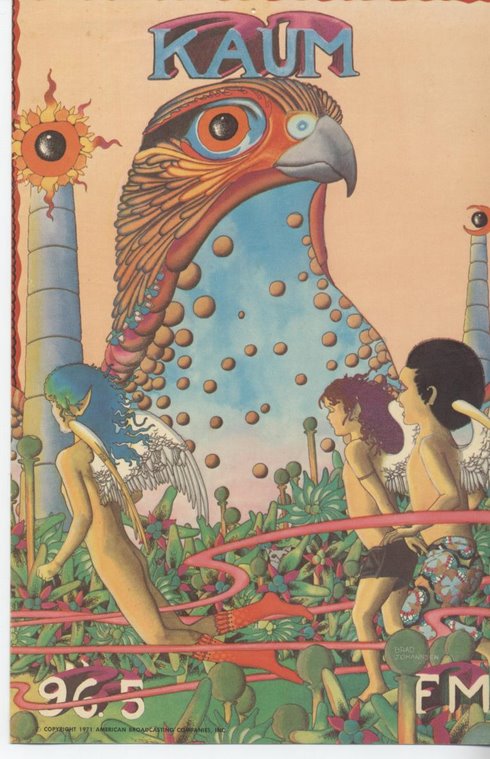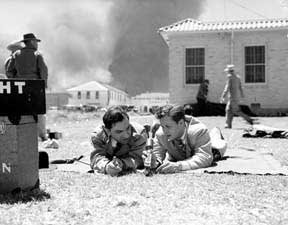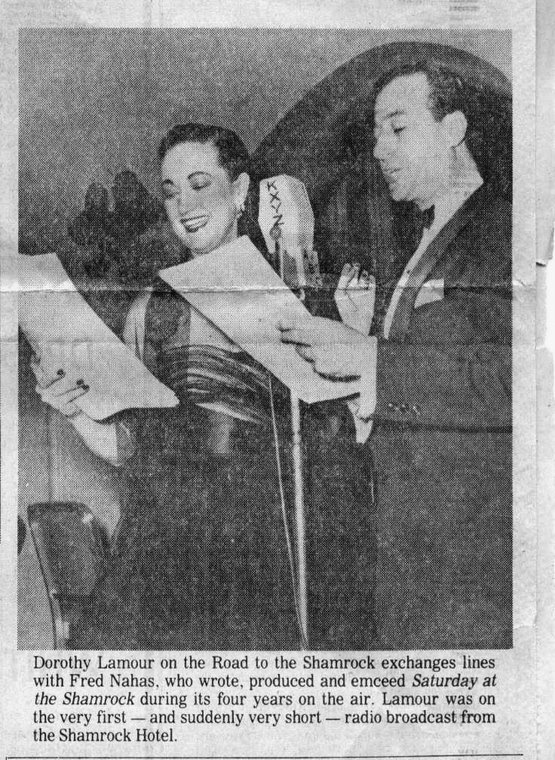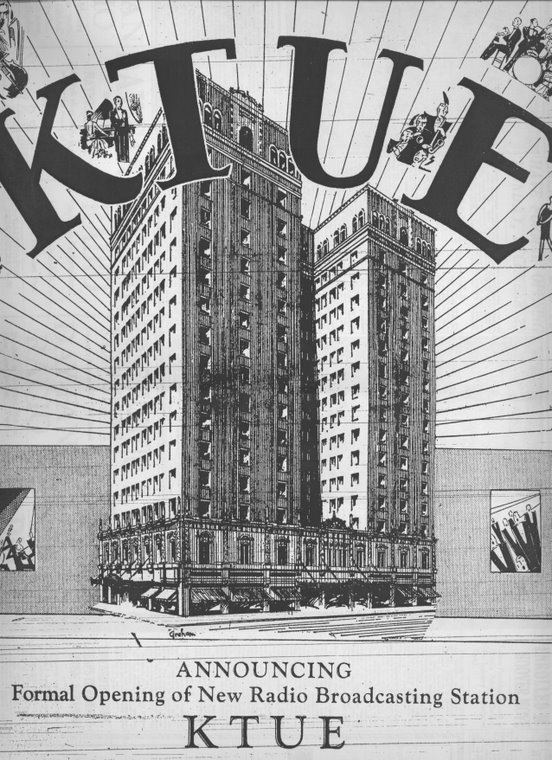A KILT Tour - 1961
My correspondent, John Hill, has provided me with a wealth of information about KILT in the early 1960s, including a description of the equipment in use at this time. This is fascinating information for radio and equipment geeks and for everyone who worked in the McLendon building over the years, and so I am reproducing it here as John related it to me. Note: KILT first occupied the facility in 1957 and moved out in 1995. Although the building is still standing, there is no broadcast equipment or operation at this location now.
In 1961, the KOST-FM (now KILT-FM) transmitter, a Gates 5KW kit, was located in the engineering workshop on the 2nd floor of the McLendon Building at 500 Lovett Blvd. The antenna was a 4-bay horizontally polarized "V" array atop the tower immediately behind the building. The UHF (News COMM) antenna was also mounted on the tower.
We ran KOST-FM from 6-midnight (the minimum time to keep a license current) and John Trotter would sign it on as "This is KOST'n KILT in Houston. At the time, KOST was "costing" KILT but, Gordon McLendon had the foresight to know what a more significant role FM would play in the future of broadcasting.
There was a lot of old paperwork at the AM transmitter site that indicated it was the original site. The Collins 5V main transmitter, and the 1V back-up transmitter, were not original. Since the McLendon's were pro-Collins, I'll guess the Collins gear was installed after they purchased the station. The antenna phasing cabinet, between the two transmitters, was earlier vintage than the Collins transmitters, but had been well maintained. The board and turntables at the transmitter site were definitely 'early marriage.'
With regard to the studio layout at the McLendon building, as you looked at the building, there were two sides. KILT occupied the left side. (John believes an insurance company occupied the right half of the building). The receptionist, copy, sales and management offices were on the first floor. The stairway, near the left front lobby glass window before the atrium, went upstairs to the studios.
On the second floor, the break room faced Lovett Blvd. Following the hallway toward the back of the building, on the left, there was the newsroom, On-Air studio #1, another much larger studio that we called "Studio B," On-Air studio #2/Recording Studio/Master Control Room, Engineering Office, and Engineering Shop. The right side of that hallway was solid wall.
Between the Newsroom and Studio #1, there was a double glass window so that the on-air newsman and on-air DJ were facing each for "tighter" production. Both had their boards in front of them.
There was another double glass window between Studio 1 and Studio B, which had a table and chairs. The back wall of Studio B had a double glass window so those at the table (voice talent) were normally looking up and through the double glass to the recording engineer, who had a board in front of him. Or, when in Studio B, the on-air DJ would have eye contact with me as I operated the on-air board in #1, there again for hand signals, nods...whatever cue, for tighter production.
With all that glass, we had visibility from the Master Control Room to the Newsroom so that the on-air newsman had eye contact with whomever was at the board of the Master. (In those instances, lights were usually turned off in Studios #1 and B...otherwise field glasses helped!)
Occasionally, the on-air jock would be in Studio B and I would be operating the on-air board while the jock was (usually) doing an interview, such as the train wreck we had when Dean Martin and Jerry Lewis came in. (We finally had to break that off, get John Trotter back in the on-air #1 and tape the interview which took over an hour for a 10 minute "clean" interview...not to mention the tape edit time). All our interviews were...uh, interesting.?!!
Equipment-wise, the Newsroom had 5-Model 19 teletypes, 4 on line and a back-up, a Collins board, several rack mounted recorders, patch panels, a Collins cartridge playback machine and our UHF transmitter/receiver for mobile news unit COMM.
On-Air #1 had a Collins board, 4 Gates turntables, 4 Collins cartridge playback machines, a rack/cabinet mounted Schaffer remote control system (AM transmitter remote controls), an FM transmitter control panel, and a rotating cartridge bin. It was pretty much a full house.
Studio B was for voice work only; it had a table with several phased mics, two wall mounted play-back speakers and about a dozen chairs. It was more like a small conference room.
On-Air #2/Recording Studio/Master Control had a Collins board, 2 Gates turntables, 2 Ampex 361 recorders on wheels, 2 Collins ATC record/playback machines, two racks with patch panels, McIntosh audio amplifiers and two rack mounted receivers for on-air monitoring. (The DJ was listening to the AM receiver, rather than his console output, so we would have another indicator if we went off the air.) On the back wall we had a cabinet with a disc cutter, its McIntosh driver amplifier and our cartridge and tape erasing devices, all of which I'm sure are long since dust-biters.
The engineering office was rather small with a desk, chairs and filing cabinets.
In the engineering shop, there was the 5KW KOST-FM Gates transmitter and the controls for the natural gas powered Onan generator that was mounted inside the FM tower base behind the building. There was also a sizable work bench with various test equipment and spare parts bins.
We replaced the older cartridge machines and all studio mics with the relatively new Collins ATC's and Telefunken microphones that were removed from the M/V Mi Amigo, which was home to McLendon’s ‘pirate’ radio ship operation off the coast of Norway, when Radio Nord was disassembled at Pier 37 in Galveston. KILT was the recipient of a good bit of studio gear.
Note: Although it was not a Houston radio station, its connection to Gordon McLendon and KILT warrants more information; for more on Radio Nord and it’s successor ship, see:
Radio Nord in Wikipedia
Pictures of Radio Nord, more pictures, and still more pictures.
Radio Atlanta in Wikipedia
Note: the Soundscapes site says the ship was outfitted at Copenhagen; John was told it was outfitted at Galveston by KILT transmitter supervisor Frank Maher. This was before John joined the station. Although both operations were referred to as 'pirate' radio stations, both actually operated under the laws of that time.
See also the KILT staff directory, the story of Bob Horn/Bob Adams, and the Hooper Ratings for this era.










6 comments:
As always, I enjoy your site very much. Knowing that I have walked in those same hallways as described in "A KILT Tour - 1961," it provides the extra thrill of having worked on the air at KILT, albeit many years later. I often wondered how long that faded sign had been on the door that said, "MASTER CONTROL." The links to the European pirate ships with the pictures were fun to explore. Thanks again for the hard work and effort you put into your site.
Chuck Tiller
Does anybody have any of the old jingle package masters for KENR?
Thanks!
Glen Ashworth
I am researching the history of Mi Amigo on December 21, 1963 prior to departure on December 29, 1963. A correspondent of yours listed Frank Maher as the person who reinstalled the CE transmitters back on the Mi Amigo at Galveston. Do you have any other information on this person?
By the way, the confusion relating to the two installations: the first was at Copenhagen. The CE transmitters were exported by stealth via Visual Electronics in NYC. The second involved a stealth loading to escape US Customs export restrictions. I am trying to determine whether 2 more new CE transmitters were also loaded in addition to the original 2 refurbished CE transmitters which had been in storage at KILT.
Sorry, I do not, Mervyn.
I will see if I can discover anything.
Further to my earlier comments, it now appears that Milan Leggett, engineer at KLIF in Dallas was the person who not only supervised the reinstallation of the CE transmitters on the Mi Amigo in Galveston, but that he sailed with the ship and worked on wiring everything up during the voyage to England. It also appears that a firm called 'BESCO' in Dallas was the intermediary between CE and the Mi Amigo. Milan Leggett later worked at 'BESCO' where he disassembled a KCUL Fort Worth transmitter for sale to the same entity that contracted for lease of the Mi Amigo, but for installation at a different location. Richard Eugene Witkovski worked for Visual Electronics in New York during the time that Radio Nord was equipped and he later became associated with BESCO. I cannot find out much about this company which seems to have been a subsidiary 'front' for a McLendon spin-off. Can anyone tell me more about Milan Leggett when he was in Texas and about the origin of 'BESCO' and involvement by Dick Witkovski?
Mervyn Hagger
Note: Mr. Hagger's comment, originally submitted for moderation on January 28, 2019, was accidentally deleted. The above is copied from the email notification I received.
Bruce Williamson
Post a Comment